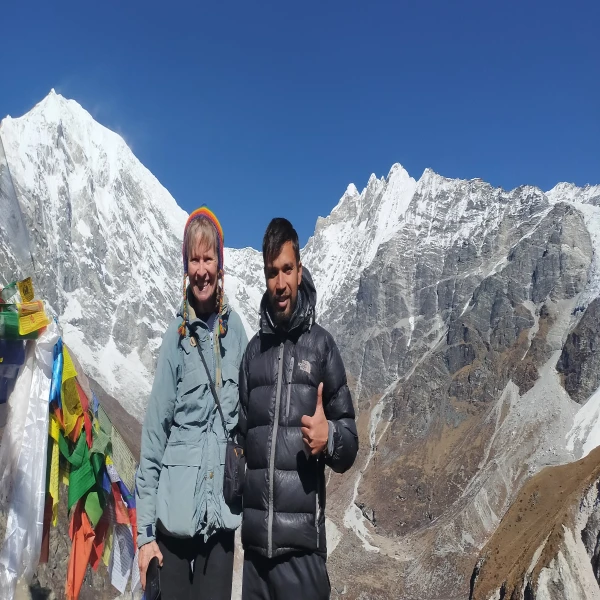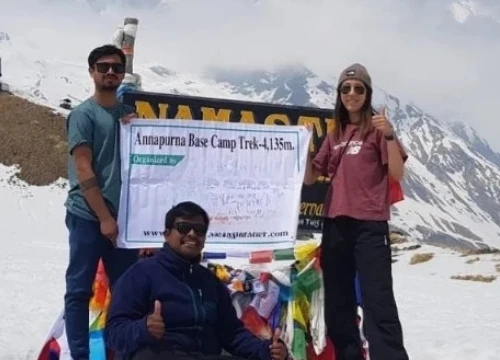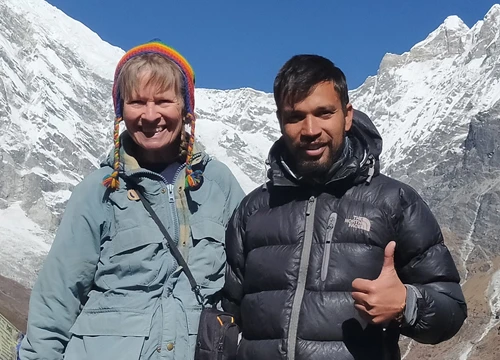As the vibrant hues of autumn set in, October beckons adventurers to explore the stunning Langtang Valley, a hidden gem nestled in the heart of the Himalayas. This captivating trek offers a unique blend of breathtaking landscapes, rich cultural experiences, and the warm hospitality of local communities. With its towering peaks and lush valleys, the Langtang Valley promises to ignite your passion for exploration like never before. Wander through charming villages, marvel at ancient monasteries, and breathe in the fresh mountain air as you embark on an unforgettable journey. Whether you're a seasoned trekker or a curious novice, this October adventure invites you to create memories that will last a lifetime, all while surrounded by the majesty of nature. Discover the allure of the Langtang Valley and experience firsthand why this trek is a must for any outdoor enthusiast. Your adventure awaits!
Langtang Valley Trek during October
Table of Contents
Langtang Valley Trek during October
As the vibrant hues of autumn set in, October beckons adventurers to explore the stunning Langtang Valley, a hidden gem nestled in the heart of the Himalayas. This captivating trek offers a unique blend of breathtaking landscapes, rich cultural experiences, and the warm hospitality of local communities. With its towering peaks and lush valleys, the Langtang Valley promises to ignite your passion for exploration like never before. Wander through charming villages, marvel at ancient monasteries, and breathe in the fresh mountain air as you embark on an unforgettable journey. Whether you're a seasoned trekker or a curious novice, this October adventure invites you to create memories that will last a lifetime, all while surrounded by the majesty of nature. Discover the allure of the Langtang Valley and experience firsthand why this trek is a must for any outdoor enthusiast. Your adventure awaits!
Why October is the Best Time for Langtang Valley Trek
October is an exceptional month for embarking on the Langtang Valley trek, offering an ideal blend of favorable weather conditions and stunning natural beauty. As the monsoon season recedes, the skies clear up, providing trekkers with crisp, blue vistas and a panoramic view of the majestic Himalayan peaks. The temperatures during this time are moderate, making it comfortable for long days of walking without the extremes of summer heat or winter cold. This perfect balance of climate ensures that trekkers can enjoy their journey without the added burden of weather-related challenges.
The autumn season brings with it a riot of colors, transforming the Langtang Valley into a vibrant tapestry of reds, oranges, and yellows. The lush forests and alpine meadows are adorned with blooming wildflowers, adding to the valley's allure. The post-monsoon period also means that the trails are less muddy, making the trek safer and more enjoyable. Wildlife is more active and visible during this time, offering trekkers a chance to spot various species of birds and animals that inhabit the region. This synergy of natural elements makes October an unbeatable time to experience the Langtang Valley in all its glory.
In addition to the natural advantages, October is a time when local festivals are celebrated with great fervor. This provides trekkers with a unique opportunity to immerse themselves in the rich cultural tapestry of the region. Witnessing these traditional celebrations firsthand offers a deeper understanding and appreciation of the local customs and way of life. The combination of pleasant weather, stunning landscapes, and cultural richness makes October the prime time for adventurers seeking an unforgettable trekking experience in the Langtang Valley.
How is the route of the Langtang Valley Trek
The Langtang Valley trek begins in the bustling town of Syabrubeshi, a gateway to the Langtang National Park. From here, the trail winds its way through dense forests, crossing suspension bridges over gushing rivers, and passing through charming Tamang villages. The initial days of the trek take you through lush rhododendron and bamboo forests, where the air is filled with the scent of pine and the sounds of chirping birds. This gradual ascent allows trekkers to acclimate to the increasing altitude while enjoying the serene beauty of the surroundings.
As you move further along the trail, the landscape changes dramatically. The dense forests give way to open alpine meadows and rocky terrain, offering unobstructed views of snow-capped peaks such as Langtang Lirung, Langshisha Ri, and Dorje Lakpa. The village of Ghodatabela marks a significant point in the trek, where trekkers can take a break and marvel at the stunning vistas. Continuing onwards, you reach the heart of the Langtang Valley, the village of Kyanjin Gompa. This picturesque settlement, situated at an altitude of 3,870 meters, is home to an ancient monastery and a cheese factory, both of which are worth exploring.
The trek to Kyanjin Ri, a peak that offers a breathtaking panoramic view of the Langtang Himalayan range, is a highlight of the journey. The climb is challenging but rewarding, as the summit provides a 360-degree view of towering peaks and glaciers. After soaking in the majestic views, the descent begins, retracing the path back through the valley and eventually returning to Syabrubeshi. Throughout the trek, the well-marked trails and the presence of friendly local guides ensure that even novice trekkers can navigate the route with confidence.
Key Attractions of the Langtang Valley Trek
One of the most enchanting aspects of the Langtang Valley trek is the opportunity to visit the ancient Kyanjin Gompa monastery. This sacred site, perched on a hilltop, offers a serene environment for reflection and meditation. The monastery is adorned with intricate carvings and colorful prayer flags, creating a spiritual ambiance that resonates with trekkers. The surrounding area also provides spectacular views of the Langtang range, making it a perfect spot for photography enthusiasts.
Another notable attraction is the Langtang National Park, a biodiversity hotspot that is home to a variety of flora and fauna. Trekkers can encounter rare species such as the red panda, Himalayan black bear, and the elusive snow leopard. The park's diverse ecosystems, ranging from subtropical forests to alpine meadows, provide a rich backdrop for nature lovers. Birdwatchers will be delighted by the presence of numerous avian species, including the vibrant Danphe, Nepal's national bird. The natural beauty and ecological importance of the Langtang National Park make it a significant highlight of the trek.
The cheese factory in the village of Kyanjin Gompa is another unique attraction that adds a delightful twist to the trekking experience. Established with Swiss assistance, the factory produces delicious yak cheese, which trekkers can sample and purchase. The process of cheese-making, explained by the local workers, offers an interesting insight into the traditional practices of the region. Enjoying fresh, locally-made cheese against the backdrop of the towering Himalayas is an experience that is both memorable and unique to the Langtang Valley trek.
Essential Packing List for Langtang Valley Trek
Packing wisely is crucial for a successful and enjoyable Langtang Valley trek. Given the varying altitudes and weather conditions, it's important to carry clothing that can be layered. Start with moisture-wicking base layers to keep sweat away from your skin, followed by insulating layers such as fleece or down jackets for warmth. A waterproof and windproof outer layer is essential to protect against rain and wind. Comfortable trekking pants and thermal underwear are also recommended for colder nights.
Footwear is another critical aspect of your gear. Invest in a good pair of trekking boots that offer ankle support and have a sturdy grip for navigating rocky and uneven terrain. Break in your boots before the trek to avoid blisters. Additionally, pack several pairs of moisture-wicking socks and consider carrying gaiters to keep debris out of your boots. A pair of lightweight sandals can be useful for wearing around the teahouses and giving your feet a break after a long day of trekking.
Other essential items include a high-quality sleeping bag rated for cold temperatures, as the nights can get quite chilly. A reliable backpack with a rain cover, a headlamp with extra batteries, trekking poles, and a reusable water bottle with a filtration system are also necessary. Don't forget personal items such as sunscreen, lip balm with SPF, a first-aid kit, and any necessary medications. Packing a few energy bars and snacks can provide a quick boost during the trek. Ensuring you have all the necessary gear will help you stay comfortable and prepared for the adventure ahead.
Accommodations and Food Options at the trail of Langtang
Accommodations along the Langtang Valley trek primarily consist of teahouses, which are simple lodges run by local families. These teahouses offer basic amenities such as a bed, a blanket, and sometimes a shared bathroom. While the facilities may be modest, the warm hospitality of the hosts more than makes up for it. Staying in teahouses allows trekkers to experience the local culture and lifestyle up close. It's advisable to bring a sleeping bag for added warmth and comfort, especially at higher altitudes.
Food options in the Langtang Valley are diverse and cater to various tastes. Most teahouses serve a menu of traditional Nepali dishes, including dal bhat (rice with lentil soup), momo (dumplings), and thukpa (noodle soup). These meals are hearty and provide the necessary energy for trekking. In addition to local cuisine, many teahouses also offer a range of international dishes such as pasta, pancakes, and omelets. The ingredients are often sourced locally, ensuring fresh and wholesome meals.
One of the unique culinary experiences in Langtang is sampling the yak cheese produced in the region. The cheese is rich and flavorful, and can be enjoyed on its own or as part of a meal. Trekkers can also find a variety of snacks and beverages, including tea, coffee, and soft drinks, at the teahouses. It's important to stay hydrated, so remember to drink plenty of water and consider carrying water purification tablets or a filtration system. Overall, the accommodations and food options in Langtang are designed to provide comfort and sustenance, allowing trekkers to focus on the adventure.
Tips for First-Time Trekkers For the Langtang Valley Trek
For those embarking on their first trek in the Langtang Valley, preparation and planning are key. Start by building your physical fitness through regular exercise, focusing on cardiovascular endurance and strength training. Hiking on varied terrain with a loaded backpack can help simulate the conditions you'll encounter on the trek. Acclimatization is crucial to avoid altitude sickness, so plan your itinerary to include rest days for gradual ascent. Listen to your body and don't push yourself too hard; it's better to trek at a steady pace and take breaks as needed.
Invest in quality gear that suits the trekking conditions. Comfortable and durable footwear, layered clothing, and a good backpack are essential. Make sure to pack all necessary items without overloading your pack. It's also important to familiarize yourself with basic trekking etiquette, such as yielding to uphill trekkers, respecting local customs, and minimizing your environmental impact by carrying out all waste. Hiring a local guide can enhance your experience by providing valuable insights and ensuring your safety.
Stay informed about the weather forecast and trail conditions before setting out each day. Carry a detailed map and a reliable communication device for emergencies. Hydration and nutrition are vital, so drink plenty of water and consume balanced meals. Keep an eye on your health, and be aware of the symptoms of altitude sickness, such as headaches, dizziness, and nausea. If you experience any severe symptoms, descend to a lower altitude and seek medical attention. By following these tips, first-time trekkers can enjoy a safe and rewarding adventure in the Langtang Valley.
Safety Considerations and Health Precautions for the Langtang Valley Trek
Safety is paramount when trekking in the Langtang Valley, and taking the right precautions can help ensure a secure and enjoyable journey. One of the primary concerns is altitude sickness, which can affect anyone regardless of fitness level. To mitigate this risk, it's important to acclimate properly by ascending gradually and taking rest days. Drink plenty of water and avoid alcohol and caffeine, as they can contribute to dehydration. If you experience symptoms such as headache, nausea, or dizziness, descend to a lower altitude and seek medical advice.
Another key safety consideration is the condition of the trails. The Langtang Valley trek involves traversing rugged and sometimes unstable terrain, so it's essential to stay alert and watch your footing. Trekking poles can provide additional stability, especially on steep or slippery sections. Weather conditions can change rapidly in the mountains, so always carry appropriate gear for rain and cold. Inform someone about your trekking plans and estimated return time, and check in regularly if possible.
Health precautions include carrying a well-stocked first-aid kit with items such as adhesive bandages, antiseptic wipes, pain relievers, and any personal medications. Ensure that your vaccinations are up to date, and consider getting vaccines for diseases such as typhoid and hepatitis. Practice good hygiene by using hand sanitizer and avoiding untreated water. In case of emergencies, it's helpful to have travel insurance that covers high-altitude trekking and emergency evacuation. By adhering to safety guidelines and health precautions, you can minimize risks and focus on the incredible experience of trekking in the Langtang Valley.
Cultural Insights: How are the Local Communities of Langtang
The Langtang Valley is not only a natural wonder but also a cultural treasure trove, home to the Tamang and Sherpa communities. These indigenous groups have preserved their unique traditions and way of life for centuries, offering trekkers a glimpse into their rich cultural heritage. The Tamang people, who are the predominant inhabitants of the region, are known for their vibrant festivals, traditional music, and intricate handicrafts. Their hospitality is legendary, and visitors are often welcomed with warm smiles and open hearts.
One of the most profound cultural experiences in Langtang is visiting the ancient monasteries and stupas that dot the landscape. These sacred sites are central to the spiritual life of the local communities and offer a serene environment for reflection and meditation. The monasteries, adorned with colorful prayer flags and intricate carvings, are a testament to the region's deep Buddhist roots. Trekkers can also witness traditional ceremonies and rituals, which provide a deeper understanding of the local beliefs and practices.
The 2015 earthquake had a significant impact on the Langtang Valley, causing widespread devastation and loss. However, the resilience and spirit of the local communities have been remarkable. Rebuilding efforts have been ongoing, and the trekking industry has played a crucial role in the region's recovery. By choosing to trek in Langtang, visitors contribute to the local economy and support the livelihoods of the people. Engaging with the local communities, learning about their culture, and supporting their businesses can make your trekking experience more meaningful and rewarding.
Conclusion and Final Thoughts for Langtang Valley Trek
Embarking on the Langtang Valley trek in October offers an unparalleled adventure filled with breathtaking landscapes, rich cultural experiences, and the warm hospitality of the local communities. The combination of favorable weather, vibrant autumn colors, and clear mountain vistas makes this an ideal time to explore one of the Himalayas' hidden gems. Whether you're a seasoned trekker or a curious novice, the Langtang Valley promises to ignite your passion for exploration and create memories that will last a lifetime.
Throughout the trek, you'll encounter a diverse range of attractions, from the spiritual serenity of ancient monasteries to the ecological wonders of Langtang National Park. The unique culinary experiences, such as tasting locally produced yak cheese, add a delightful twist to your journey. Staying in teahouses run by local families not only provides comfort and sustenance but also offers a deeper connection to the region's culture and way of life. By preparing adequately and following safety guidelines, you can ensure a safe and rewarding trekking experience.
As you conclude your adventure, you'll carry with you the sights, sounds, and stories of the Langtang Valley. The towering peaks, lush valleys, and vibrant communities leave an indelible mark on the heart of every traveler. This trek is not just a physical journey but a soulful exploration of nature's grandeur and human resilience. So pack your bags, lace up your boots, and set out on an October adventure that promises to be as enriching as it is exhilarating. Your Langtang Valley trek awaits, offering an experience that is truly unforgettable.







